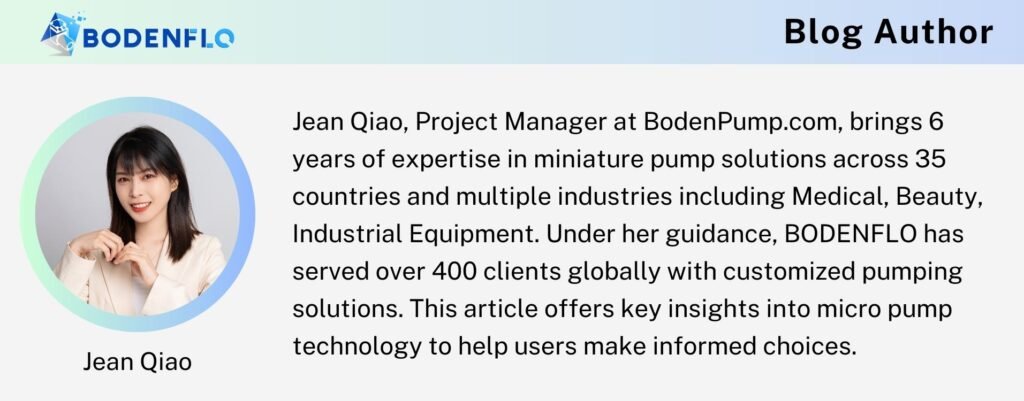
Choosing the correct pump for specific applications in fluid mechanics and engineering significantly impacts the efficiency and functionality of your system. As an expert in micro pump technologies at BODENFLO, I often guide clients through the decision-making process, particularly between piston pumps and peristaltic pumps, which are fundamentally different in both design and operation.
Piston pumps utilize a piston's motion within a cylinder to create pressure and move air or gases, whereas peristaltic pumps use a rotating wheel to compress a tube, moving fluids sequentially through it.
Let’s explore these differences to better understand which pump might be best for your specific needs.
How Do Micro Piston Air Vacuum Pumps Function?
Micro piston air vacuum pumps operate by drawing air or gas into a cylinder as the piston moves downwards, creating a vacuum. On the upward stroke, the air or gas is compressed and expelled through the outlet valve. This capability to create both vacuum and positive pressure makes them incredibly versatile for a range of applications requiring precise gas management.
Detailed Components and Their Roles:
- Piston: The primary moving part, the piston reciprocates within the cylinder to create necessary suction and subsequently expels the air.
- Cylinder: This component houses the piston and is essential for the controlled compression and decompression of the air or gas.
- Valves: Check valves are critical as they ensure directional control of the airflow, preventing any potential backflow which could disrupt system operations.
- Drive Mechanism: These pumps are typically powered by electric motors, which can be either brush or brushless, depending on the application requirements. This flexibility allows for customization to meet specific operational demands, ensuring optimal performance and reliability.
What Are the Core Applications of Micro Piston Pumps?
Micro piston pumps are preferred in industries that demand high reliability and precision air management. These pumps are especially prevalent in applications that cannot tolerate contamination, such as in medical devices for respiratory therapy and in environmental monitors where precise sampling of air quality is crucial.
Broad Applications Include:
- Medical and Healthcare: These pumps are integral to medical devices that rely on clean and controlled airflow, such as ventilators and anesthesia machines.
- Environmental Systems: Micro piston pumps are indispensable in environmental monitoring equipment, where they facilitate precise air sampling critical for assessing pollution levels.
- Consumer Products: Beyond industrial and medical applications, these pumps enhance the functionality of consumer products such as vacuum cleaners and sophisticated air conditioning systems, where they improve efficiency and user experience.
How Do Peristaltic Pumps Achieve Fluid Movement?
Operating on a principle that mimics natural biological processes such as peristalsis, peristaltic pumps are uniquely designed to handle sensitive fluids without contamination. A set of rollers compresses a flexible tube laid out in a circular track, propelling the fluid through the pump without any contact with mechanical parts. This non-invasive pumping action is crucial for maintaining the sterility and integrity of the fluids being handled, making these pumps ideal for the pharmaceutical and food industries.
Advantages of Using Peristaltic Pumps:
- Prevention of Contamination: The design ensures that fluids remain untainted by external contaminants, crucial for applications involving sensitive substances.
- Ease of Maintenance: The simplicity of the tube replacement process reduces both downtime and maintenance costs, providing an efficient solution for continuous operations.
Which Pump Type Offers Superior Efficiency?
Efficiency in pump technology is measured not only in terms of energy consumption but also through considerations of operational lifespan and maintenance needs. Micro piston air vacuum pumps excel in applications requiring efficient gas management, demonstrating high energy efficiency and reduced operational costs. Peristaltic pumps, while less efficient in terms of energy usage, offer significant advantages in terms of maintenance and operational simplicity.
Efficiency in Different Industries:
- Healthcare and Environmental: Micro piston pumps are preferred for their ability to handle gas precisely and cleanly, making them indispensable in clinical and environmental settings.
- Pharmaceutical and Food Processing: The non-contaminating nature of peristaltic pumps makes them ideal for these industries, where maintaining fluid integrity is paramount.
Why Choose BODENFLO Micro Piston Pumps?
At BODENFLO, our micro piston pumps are designed with precision engineering to meet the highest standards of performance and reliability. Our pumps are tailored to meet the demanding needs of industries where efficiency, reliability, and cleanliness are paramount. The compact and robust design of our micro piston pumps ensures they can be integrated into various applications, providing a reliable solution for managing air and gases.
BODENFLO's Commitment:
- Superior Performance: We guarantee pumps that deliver not only in terms of performance but also in durability and operational excellence.
- Custom Solutions: Our specialization in developing customized pump solutions ensures that our products perfectly align with our clients' specific operational needs.
Conclusion
Whether your application requires handling fluids or gases, understanding the key differences between piston and peristaltic pumps can guide you to the most suitable choice. At BODENFLO, we ensure that our pump technologies, especially our piston pumps, are at the forefront of industry standards, providing you with reliable and efficient solutions tailored to your needs.


